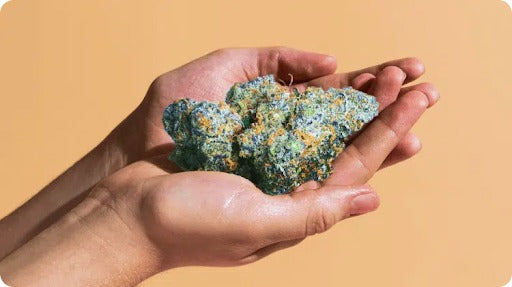
The Buyer's Guide to Instantly Spotting Great THCA Flower
Share
The THCA flower market has exploded in recent years, offering cannabis enthusiasts a legal pathway to experience premium flower nationwide. But with this growth comes a challenge: how do you separate exceptional THCA flower from mediocre products flooding the market? Whether you're a seasoned connoisseur or new to the scene, knowing what to look for can mean the difference between a disappointing purchase and discovering your new favorite strain.
At Goldy's Flower, we've witnessed firsthand how the craft of cannabis cultivation has evolved over decades in California's legendary Emerald Triangle. Our partnerships with multi-generational farmers have taught us that truly exceptional THCA flower isn't just about potency it's about the marriage of terroir, cultivation methods, genetics, and time-honored curing techniques that create an unparalleled experience.
Understanding THCA Flower: The Foundation of Quality
Before diving into quality indicators, it's essential to understand what makes THCA flower unique. THCA (tetrahydrocannabinolic acid) is the non-psychoactive precursor to THC found in raw cannabis. When exposed to heat through smoking, vaping, or cooking, THCA converts to Delta-9 THC, producing the familiar effects cannabis users seek.
The 2018 Farm Bill created a legal loophole by defining hemp as cannabis containing no more than 0.3% Delta-9 THC. This means THCA-rich flower can be legally shipped nationwide, provided it meets this threshold when tested in its raw form. The result? Premium cannabis experiences delivered legally to your doorstep, regardless of your state's cannabis laws.
Visual Inspection: Your First Line of Defense
Trichome Coverage and Quality
Exceptional THCA flower should shimmer with a generous coating of trichomes the tiny, crystal-like structures that house cannabinoids and terpenes. Under close inspection, these trichomes should appear milky white or slightly amber, not clear or completely brown. Clear trichomes indicate premature harvest, while overly brown ones suggest degraded cannabinoids.
Quality trichomes should be intact, not broken or knocked off during handling. If you notice excessive "kief" or crystal dust at the bottom of your container, it's often a sign of rough handling or over-dry flower.
Bud Structure and Density
Premium THCA flower typically exhibits a balanced density firm enough to indicate proper curing but not so dense that it feels compressed or artificial. Sun-grown flower, like what we source from Emerald Triangle farms, often has a more natural, less uniform appearance compared to indoor cultivation. This irregularity is actually a positive sign, indicating the plant developed naturally under varying environmental conditions.
Look for well-formed buds with visible calyx development and minimal stem content. The flower should maintain its structural integrity without crumbling when gently squeezed, yet shouldn't be so compressed that it feels hard or unnatural.
Color Palette and Consistency
High-quality THCA flower displays a rich, varied color palette. Deep greens should dominate, often accented with purple hues, orange pistils, and the aforementioned crystal coating. Avoid flower that appears overly brown, yellow, or has suspicious dark spots that could indicate mold or poor storage conditions.
The colors should appear vibrant and natural, not faded or dull. Sun-grown flower often exhibits more complex coloration due to natural UV exposure and temperature variations that indoor growing cannot replicate.
Aromatic Profile: The Nose Knows Quality
Terpene Expression
The aroma of premium THCA flower should be immediately apparent and complex. These aromatic compounds, called terpenes, not only contribute to scent but also influence effects and flavor. Quality flower will have a pronounced, pleasant aroma that fills the room when properly stored containers are opened.
Common terpene profiles include citrusy limonene, piney pinene, earthy myrcene, and floral linalool. The best THCA flower will have layered scent profiles that evolve as you examine the flower more closely. If the flower lacks aroma or smells musty, stale, or off-putting, it's likely old, improperly cured, or of poor quality.
Avoiding Red Flags
Several aromatic red flags should immediately concern any buyer. A hay-like smell often indicates improper drying or curing. Musty or moldy odors are obvious indicators of contamination. Chemical or artificial smells might suggest the use of synthetic additives or improper storage with foreign substances.
Quality THCA flower should never smell like nothing a complete lack of aroma usually indicates either very old flower or products that have been over-processed, stripping away the natural terpenes that contribute to both scent and effects.

The Perfect Balance
Premium THCA flower should have an optimal moisture content typically between 8-12%. The flower should feel slightly springy when gently squeezed, breaking apart cleanly without crumbling to dust or feeling wet and sticky. Properly cured flower will have a slight give when pressed but will spring back to its original shape.
Over-dry flower will crumble easily and burn too quickly, creating harsh smoke and degraded flavors. Conversely, flower with too much moisture can harbor mold and bacteria while being difficult to burn properly.
The Stem Test
A simple quality test involves examining the stems within the flower. In premium THCA flower, smaller stems should snap cleanly when bent, while larger stems should bend slightly before breaking. This indicates proper moisture content and curing. Stems that are too brittle suggest over-drying, while stems that bend excessively without breaking may indicate excess moisture.
Laboratory Testing and Transparency
Essential Testing Parameters
Reputable THCA flower vendors should provide comprehensive laboratory testing results, typically called Certificates of Analysis (COAs). These documents should test for:
- Cannabinoid profiles (THCA, CBD, minor cannabinoids)
- Terpene profiles
- Pesticide screening
- Heavy metals testing
- Microbial contamination (mold, bacteria, yeast)
- Residual solvents (if applicable)
Quality producers test every batch, not just representative samples, ensuring consistency and safety across their entire product line.
Reading COAs Effectively
When examining test results, look for THCA percentages that align with the vendor's claims. Be wary of results that seem too good to be true or inconsistent with the flower's appearance and aroma. Terpene profiles should complement the aromatic experience you observe.
Pay particular attention to contamination testing. Any detectable levels of pesticides, heavy metals, or microbials should be well within acceptable limits established by state regulatory bodies.
Source and Cultivation Methods
The Terroir Advantage
Just as wine reflects its terroir, exceptional THCA flower carries the signature of its growing environment. The Emerald Triangle's Mediterranean climate, fertile soils, and generations of cultivation expertise create conditions that are difficult to replicate elsewhere. This region's unique combination of cool, foggy mornings and warm, sunny afternoons allows plants to develop complex terpene profiles and robust cannabinoid production.
Cultivation Philosophy
Premium THCA flower typically comes from cultivators who prioritize plant health over maximum yield. This means organic or regenerative farming practices, hand-trimming, slow curing processes, and attention to phenotype selection. Small-batch cultivation allows for individual plant attention that large-scale operations cannot provide.
Sun-grown flower often exhibits superior terpene development compared to indoor alternatives, as natural light spectrums and environmental variations encourage the plant's full genetic expression.

Proper Packaging Indicators
Quality THCA flower should arrive in packaging that preserves its integrity. Look for opaque containers that protect from light degradation, airtight seals that maintain moisture content and prevent contamination, and materials that don't impart foreign odors or flavors.
Avoid products packaged in clear containers that have been exposed to light, vacuum-sealed packages that may have over-compressed the flower, or containers with damaged seals that could indicate tampering or improper storage.
Storage Best Practices
Once you've identified quality THCA flower, proper storage is crucial for maintaining its characteristics. Store in a cool, dark place with stable temperature and humidity. Glass containers with airtight seals work best for long-term storage, while avoiding plastic bags that can create static and damage trichomes.
Price vs. Quality: Finding Value
Understanding Premium Pricing
Exceptional THCA flower commands premium prices for good reason. The costs associated with small-batch cultivation, organic growing methods, hand-trimming, proper curing, comprehensive testing, and sustainable packaging all contribute to higher prices.
However, expensive doesn't always mean better. Some vendors inflate prices without corresponding quality improvements. Focus on the quality indicators outlined above rather than price alone when making purchasing decisions.
Value Considerations
Consider the total experience when evaluating value. Premium THCA flower may cost more per gram but often provides a more satisfying experience with better flavor, smoother smoke, and more consistent effects. Additionally, properly cured flower typically burns more efficiently, potentially providing better value per session.
Conclusion: Elevating Your THCA Experience
Spotting great THCA flower requires attention to multiple quality indicators working in harmony. From the visual appeal of crystal-covered buds to the complex aromatic profiles that indicate proper terpene development, each element contributes to the overall experience.
At Goldy's Flower, we believe that exceptional THCA flower represents more than just a product it's a connection to the rich heritage of cannabis cultivation, the unique terroir of California's Emerald Triangle, and the dedication of multi-generational farmers who have perfected their craft over decades.
Frequently Asked Questions
What's the difference between THCA flower and regular cannabis?
THCA flower is essentially regular cannabis that meets the legal definition of hemp (containing less than 0.3% Delta-9 THC when tested raw). When heated, the THCA converts to Delta-9 THC, providing similar effects to traditional cannabis. The main differences are legal status and the conversion process that occurs during consumption.
How can I tell if THCA flower is fresh?
Fresh THCA flower should have a strong, pleasant aroma, proper moisture content (slightly springy when squeezed), vibrant colors, and intact trichomes. Avoid flower that smells like hay, crumbles to dust, appears faded, or lacks aroma entirely.
Is more expensive THCA flower always better?
Not necessarily. While quality cultivation and processing do increase costs, some vendors may inflate prices without corresponding quality improvements. Focus on the quality indicators discussed in this guide rather than price alone. The most expensive option isn't always the best value.
How should I store THCA flower to maintain quality?
Store THCA flower in airtight, opaque containers in a cool, dark place with stable temperature and humidity. Glass containers work best for long-term storage. Avoid exposure to light, heat, air, and moisture, which can degrade cannabinoids and terpenes.
What should I look for in lab testing results?
Comprehensive lab results should include cannabinoid profiles, terpene profiles, pesticide screening, heavy metals testing, and microbial contamination testing. Look for results that match the product's description and ensure all contamination levels are within acceptable limits.
Can I tell quality just by looking at THCA flower?
Visual inspection is an important first step, but it shouldn't be your only quality assessment method. Combine visual examination with aroma evaluation, texture assessment, and review of laboratory testing results for a complete quality picture.
How long does quality THCA flower stay fresh?
Properly stored THCA flower can maintain quality for 6-12 months, though peak freshness typically lasts 2-4 months. Factors affecting longevity include initial quality, storage conditions, and packaging methods.
What's the most important quality indicator for THCA flower?
While all factors are important, the combination of strong terpene expression (aroma) and comprehensive, clean laboratory testing results are typically the most reliable indicators of overall quality. These factors indicate both proper cultivation and processing as well as safety for consumption.



